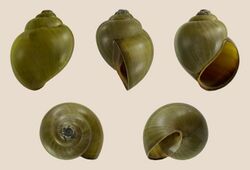Biology:Pila (gastropod)
| Pila | |
|---|---|

| |
| A shell of Pila virescens | |
| Scientific classification | |
| Domain: | Eukaryota |
| Kingdom: | Animalia |
| Phylum: | Mollusca |
| Class: | Gastropoda |
| Subclass: | Caenogastropoda |
| Order: | Architaenioglossa |
| Family: | Ampullariidae |
| Genus: | Pila Röding, 1798[1] |
| Type species | |
| Helix ampullacea Linnaeus, 1758 | |
| Diversity[2] | |
| about 30 species | |
| Synonyms | |
| |
Pila is a genus of large freshwater snails with an operculum, African and Asian apple snails, aquatic gastropod mollusks in the family Ampullariidae, the apple snails.
Distribution
Distribution of the genus Pila include Africa, Madagascar, southern Asia and Indo-Pacific islands. It is amphibious in nature and can undergo summer sleep or aestivation under drought condition. It is generally found in lakes, pools, and sometimes even in the river streams where aquatic vegetation like Vallisneria, Pistia are found in large amount for food.[3]
External Features
When viewed from ventral side facing the collumella towards the observer, the collumella rotates clockwise or Dextral.
Species
Species within the genus Pila include:
subgenus Pila
- Pila africana (v. Martens, 1886)[2][3]
- Pila ampullacea (Linnaeus, 1758) - type species[2][3]
- † Pila assermoensis (Jodot, 1953)
- Pila brohardi (Granger, 1892)[2]
- † Pila busserti Harzhauser & Neubauer in Harzhauser et al., 2017
- Pila cecillei (Philipi, 1848)[2][3]
- † Pila celebensis (Quoy & Gaimard, 1834)
- † Pila colchesteri Cox, 1933
- Pila decocta (Mabille, 1887)
- † Pila falloti (Jodot, 1953)
- † Pila faujasii (Serres, 1829)
- † Pila gauthieri (Jodot, 1953)
- Pila globosa (Swainson, 1822)[2]
- Pila gracilis (I. Lea, 1856)
- Pila mizoramensis Sil, Basak, Karanth & Aravind, 2021
- † Pila mutungi Van Damme & Pickford, 1995
- † Pila neuberti Harzhauser & Neubauer in Harzhauser et al., 2016
- Pila nevilliana (Annandale & Prashad, 1921)
- Pila occidentalis (Mousson, 1887)[2][3]
- Pila ovata (Olivier, 1804)[2][3]
- Pila pesmei (Morelet, 1889)[2]
- Pila saxea (Reeve, 1856)[2]
- Pila scutata (Mousson, 1848)[2][4]
- Pila speciosa (Philippi, 1849)[2][3]
- Pila turbinis (I. Lea, 1856)
- Pila virens (Lamarck, 1822)[2]
- Pila virescens (Deshayes, 1824)
- Pila wernei (Philipi, 1851)[2][3]
subgenus Turbinicola Annandale & Prashad, 1921[5]
- Synonyms
- Pila aldersoni Pain, 1946: synonym of Pomacea aldersoni (Pain, 1946) (original combination)
- Pila angelica (Annandale, 1920): synonym of Pila celebensis (Quoy & Gaimard, 1834)
- Pila conica (Wood, 1828): synonym of Pila scutata (Mousson, 1848)
- Pila gradata (E. A. Smith, 1881): synonym of Pila ovata (Olivier, 1804)
- Pila hollingsworthi T. Pain, 1946: synonym of Pomacea hollingsworthi (Pain, 1946) (original combination)
- Pila polita (Deshayes, 1830): synonym of Pila virescens (Deshayes, 1824)
- † Pila selvensis (Vidal, 1917) †: synonym of † Selvovum selvense (Vidal, 1917)
Ecology
Pila species are a host of a trematode Multicotyle purvisi.[6]
Human use
The shells of Pila are used in traditional ethnomedicine for weakness by Saharia people in Rajasthan, India.[7]
Pila ampullacea and Pila pesmei are some of the rice field snail species traditionally eaten in Thailand that have been displaced by the invasive golden apple snail, Pomacea canaliculata.[8]
References
- ↑ Röding P. F. (1798). Museum Boltenianum sive catalogus cimeliorum e tribus regnis naturæ quæ olim collegerat Joa. Fried Bolten, M. D. p. d. per XL. annos proto physicus Hamburgensis. Pars secunda continens conchylia sive testacea univalvia, bivalvia & multivalvia. pp. [1-3], [1-8], 1-199. Hamburg. page 145.
- ↑ 2.00 2.01 2.02 2.03 2.04 2.05 2.06 2.07 2.08 2.09 2.10 2.11 2.12 2.13 2.14 2.15 "Pila". The apple snail website, Accessed 16 May 2011.
- ↑ 3.0 3.1 3.2 3.3 3.4 3.5 3.6 3.7 Brown D. S. (1994). Freshwater Snails of Africa and their Medical Importance. Taylor & Francis. ISBN:0-7484-0026-5.
- ↑ Bouchet, P. (2013). Pila scutata (Mousson, 1848). In: MolluscaBase (2017). Accessed through: World Register of Marine Species at http://www.marinespecies.org/aphia.php?p=taxdetails&id=739934 on 2017-11-23
- ↑ Annandale N. & Prashad B. (1921). Rec. Indian Mus. 22: 9.
- ↑ Alevs, Philippe V.; Vieira, Fabiano M.; Santos, Cláudia P.; Scholz, Tomáš; Luque, José L. (2015-02-12). "A Checklist of the Aspidogastrea (Platyhelminthes: Trematoda) of the World" (in en). Zootaxa 3918 (3): 339–96. doi:10.11646/zootaxa.3918.3.2. ISSN 1175-5334. PMID 25781098. http://biotaxa.org/Zootaxa/article/view/zootaxa.3918.3.2.
- ↑ Mahawar, M. M.; Jaroli, D. P. (2007). "Traditional knowledge on zootherapeutic uses by the Saharia tribe of Rajasthan, India". Journal of Ethnobiology and Ethnomedicine 3 (1): 25. doi:10.1186/1746-4269-3-25. PMID 17547781.
- ↑ Heavy Predation on Freshwater Bryozoans by the Golden Apple Snail, Pomacea canaliculata Lamarck, 1822 (Ampullariidae); The Natural History Journal of Chulalongkorn University 6(1): 31-36, May 2006
External links
- Swainson, W. (1840). A treatise on malacology or shells and shell-fish. London, Longman. viii + 419 pp.
- Repelin, J. (1902). Description des faunes et des gisements du Cénomanien saumâtre ou d'eau douce du Midi de la France. Annales du Musée d'histoire naturelle de Marseille. Section de Géologie. 7: 1-133
- Lamarck, J.B.M. (1799). Prodrome d'une nouvelle classification des coquilles, comprenant une rédaction appropriée des caractères géneriques, et l'établissement d'un grand nombre de genres nouveaux. Mémoires de la Société d'Histoire Naturelle de Paris. 1: 63-91
- Montfort P. (Denys de). (1808-1810). Conchyliologie systématique et classification méthodique des coquilles. Paris: Schoell. Vol. 1: pp. lxxxvii + 409 [1808]. Vol. 2: pp. 676 + 16 ,1810
- Cowie, R. H. & Thiengo, S. C. (2003). The apple snails of the Americas (Mollusca: Gastropoda: Ampullariidae: Asolene, Felipponea, Marisa, Pomacea, Pomella): A nomenclatural and type catalog. Malacologia. 45(1): 41-100.
- Cowie R.H. (2015). The recent apple snails of Africa and Asia (Mollusca: Gastropoda: Ampullariidae: Afropomus, Forbesopomus, Lanistes, Pila, Saulea): a nomenclatural and type catalogue. The apple snails of the Americas: addenda and corrigenda. Zootaxa. 3940(1): 1-92
- enson, W. H. (1829). Description of the animal of Ampullaria, a genus of freshwater Testacea, with a notice of two species inhabiting the freshwaters of the Gangetic Provinces. Gleanings in Science. 1(2): 52-54.
Wikidata ☰ Q657252 entry
 |

